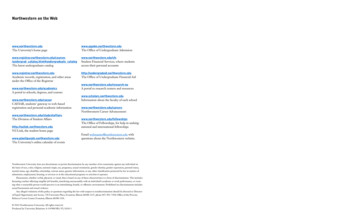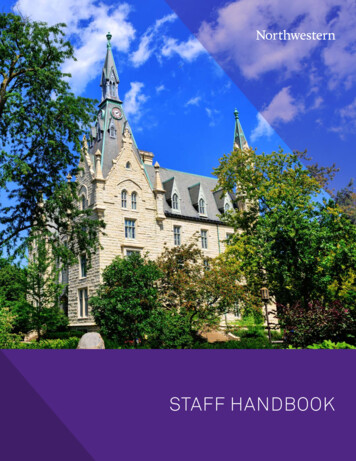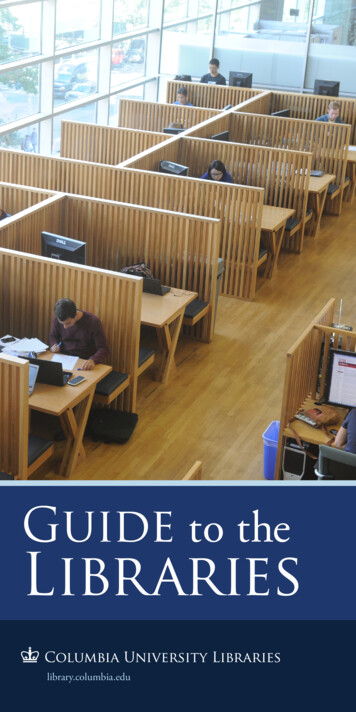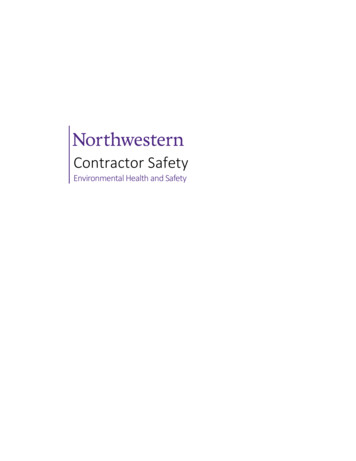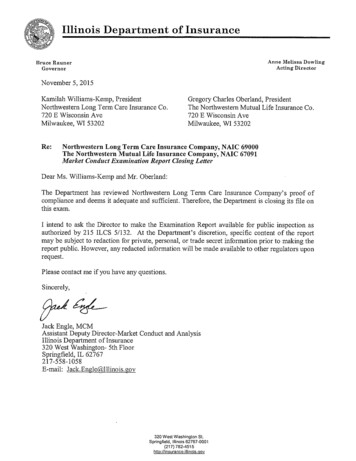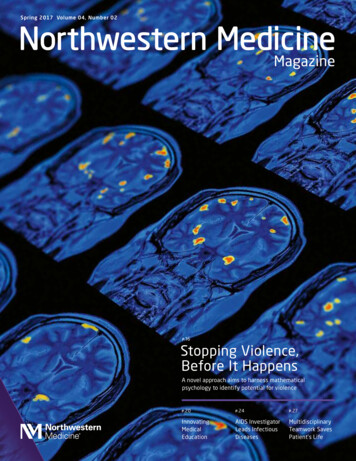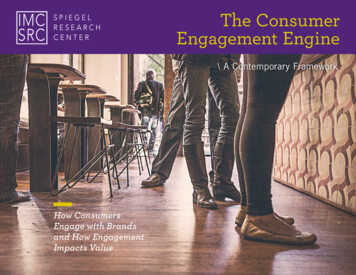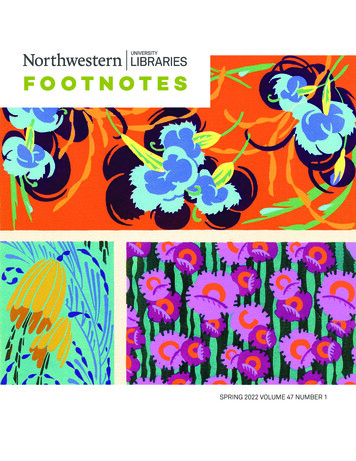
Transcription
FOOTNOTESSPRING 2022 VOLUME 47 NUMBER 1
FOOTNOTESS P R I N G 2 0 2 2 , V O L U M E 4 7, N U M B E R 11A dean’s farewell2Sarah Pritchard’s accomplishments forge“world-class research hub”8Electronic music pioneer’s archive comesto Music Library10 Exploding tenacious myths about Madagascar12 Here to help: Video Production StudioFootnotes is publishedtwice a year by NorthwesternUniversity Libraries.www.library.northwestern.eduDean of Libraries andCharles Deering McCormickUniversity Librarian:Sarah M. Pritchardspritchard@northwestern.eduDirector of Development:Jennifer Mullman ’99jmullman@northwestern.eduDirector of Marketing andCommunication:Clare Roccafortec-roccaforte@northwestern.eduCover: From Formes et couleurs: vingt planchesen couleurs, contenant soixante-sept motifsdécoratifs by Auguste H. Thomas (Paris, 1921),a collection of Art Deco motifs for artists.Charles Deering McCormick Library of SpecialCollections and University Archives.Editor and Writer:Drew Scott ’92drew.scott@northwestern.eduPhotography: Matthew Gilson,Bruce Powell, Jim PrischingNorthwestern University is committed to providing a safe environment free from discrimination, harassment,sexual misconduct, and retaliation. To view Northwestern’s complete nondiscrimination statement, scrimination-statement.html, and for crime and safety data,see eports.html. 2022 Northwestern University. Produced by Global Marketing and Communications. 6-22/9M/NL-GD/3216NORTHWESTERN UNIVERSITYLIBRARIES BOARD OF GOVERNORSStephen M. Strachan ’17 P, chairMegan P. Anderson ’76, ’03 PMarie Arana ’71Robert D. Avery ’66Suzanne S. Bettman ’86Frederick L. Brown ’62Jennifer Cain Brown ’05Jane Burke* ’85 MBAAnne T. CoughlanJames F. Freundt ’72Byron L. Gregory ’66, ’69 JDKenneth R. Herlin ’69, ’73 MBAPeter Hong ’79, ’81 MBA, ’15 PKathryn D. Ingraham ’90Joan M. Johnson ’90 MBADaniel S. Jones ’61, ’91 PJames A. Kaduk ’75 MS, ’77 PhD, ’05 PVictoria Mitchell Kohn ’96 PStephen C. Mack ’69, ’70 MBA, ’96 P, ’99 PMarc McClellan ’81Nancy McCormickHoward M. McCue III*Deirdre McKechnie* ’82, ’10 P, ’14 PPeter B. McKee ’60, ’03 P, ’06 PM. Julie McKinley* ’17 PYelda Basar Moers ’98Dante Pieramici ’87, ’24 PEvelyn Riedel ’83, ’20 PSandi L. Riggs ’65Marcia Ryles ’81, ’15 PJulie F. Schauer ’76Robert A. Seal ’71Gordon I. Segal ’60, ’93 PAlan H. Silberman* ’61, ’93 PEric B. Sloan ’87John H. Stassen* ’65, ’99 PJohn C. Ver SteegSarah M. Pritchard, ex officioJennifer Mullman ’99, ex officio*emeritus
A dean’s farewellour most ambitious plans to fruition,whether it is the evolution of library culture, the growth in our digital services,or the extraordinary upgrades in ourphysical facilities and spaces. Even someof our archival gifts have taken 10 yearsto negotiate!Two-thirds of our budget is forpeople; thus, two-thirds of my job isabout people. One of the constant joys Ihave had here is seeing our people growin their careers. When you’re trying tobring change, you can’t just throw moneyat problems; you need the right people,and you need to foster their developmentand diversity. I am blessed to have beensurrounded by so many smart, hardworking colleagues in the Libraries.When I took this job in 2006, thenBy now you’ve seen last fall’s announcement that I willpresident Henry Bienen handed me the report on thebe stepping down this August after 16 years at the headrecently completed program review, the thorough third-of this wonderful organization. This is one of my lastparty assessment every campus department undergoeschances to address you, our biggest supporters; toonce a decade or so. That document provided a road mapexpress my gratitude for your commitment; and tofor the expectations ahead for the Libraries, and I’mencourage you to stay involved as the Northwesternproud of how our team answered those challenges.Libraries enter a future filled with promise.Serendipitously, incoming dean Xuemao Wang willIt’s bittersweet to leave at this moment. After sohave a fresh copy of the 2022 program review to providemany years of growing our services and collections andsimilar focus. I’m confident that the Northwesterncarefully cultivating a forward-looking work culture,University Libraries—and their librarians—are readymy tenure ends with the bruising effects of the COVID-for the next set of ambitious goals set out by new leader-19 pandemic. Yet I’m so proud of our rally in the face ofship. I believe there’s nothing this team can’t do.this challenge. The Libraries came out of this periodThank you again for believing in us and helpingwith renewed ingenuity and perseverance to serve ourthese Libraries become the powerhouse engine forcommunity in any way we can.research and teaching that befits our great University.The pandemic forced us to change over a short time.Yet library work is very longitudinal, and most of theinitiatives we undertake require long-term planning andsustained effort over years. Changes in leadership, technology, and community needs can throw us curveballsSarah M. Pritchardwhen we are executing a vision. This is why I view myDean of Libraries and Charles Deering McCormicklong tenure here as a gift. I’ve been able to see many ofUniversity LibrarianSPRING 2022FOOTNOTES1
SARAH PRITDean’s accomplishmentsforge “the world-classresearch hub thisUniversity deserves”When Sarah Pritchard took thehelm of Northwestern Libraries in2006, she heard one refrain frommany on campus. “We don’t knowwhat’s going on in the Libraries. It’s like ablank to us,” Pritchard recalled being told.“What do they do in there?”Northwestern’s provost agreed, telling herthat whatever else needed to be addressed,the Libraries just weren’t visible enough oncampus.Reflecting on her career, she gave a briefassessment of that early criticism: “Boy, havewe changed that.”Pritchard will step down in August as dean ofthe Libraries and Charles Deering McCormick University Librarian after 16 years at Northwestern and atotal of 45 in academic and research institutions. Looking back, she is proud of how the Libraries respondedto the provost’s critique by becoming a proactiveresearch partner, locus for digital innovation, andstudent-centered hub, and she is grateful for her longtenure, which allowed her to see her plans play outand to engage in so many collaborations.2FOOTNOTESSPRING 2022
ITCHARDSPRING 2022FOOTNOTES3
OGLC’s debut in 2011 tookpressure off crowdedNorthwestern library facilitiesand provided the flexibility toreimagine spaces for studentsand services.It’s remarkable to be in one place long enough to seethings come to fruition.”Pritchard has seen enough fruition at Northwesternto plant her own orchard. She oversaw many ambitiousprojects, while supporting librarians and staff toexperiment with their own expressions of a responsive,service-minded institution.A look back at Pritchard’s career reveals a libraryorganization maneuvering its way into the digital agewhile grappling with issues of space, service culture,and collections growth.Reimagining library spacesEarly on, Pritchard identified looming space constraintsand launched a 20-year strategic plan to analyze andaddress the space needs of University, Deering, Mudd,and the Chicago campus libraries. The comprehensiveplan informed the landmark facilities initiatives thatmarked Pritchard’s time here, and it still holds up as avision document, she said.The most significant achievement is the 2011 opening of the Oak Grove Library Center in Waukegan, IlliPritchard previously led libraries at Smith Collegenois. OGLC is a high-density, climate-controlled shelvingand the University of California, Santa Barbara, butfacility with the capacity to house three million items—her tenure at each was about half the length of her timeand room to grow. Its debut instantly took pressure offat Northwestern. She noted that having 16 years tocrowded Northwestern library facilities and providedlead is an increasingly rare occurrence in the academicthe flexibility to rethink spaces for students and ser-library world.vices. Many areas once packed with shelves now bustleBecause research libraries are such complex organisms, she said, a shorter stint would have stymied long-with students collaborating and creating.In 2012 Pritchard oversaw the reopening of Deeringterm planning for expanded services, infrastructureLibrary’s front doors, which had been closed since Uni-growth, improved workflows, and cultural change,versity Library opened in 1970. The project resulted inall pillars of Pritchard’s vision. Such comprehensivea redesigned entry lobby with improved accessibility,advancements require large teams internally and broadsecurity, and climate control, as well as an expandedsupport externally; meanwhile, budget constraints, staffplaza that serves as a stage for events held on Deeringturnover, and campus leadership changes can impedeMeadow. Additional renovations to Deering are now inprogress—to say nothing of the chaos brought on by athe planning phase.global pandemic.Seeley G. Mudd Library opened in 1977 as the home“This work is lengthy and fragile,” she said. “Thetypes of initiatives we do take so long to bring about.4FOOTNOTESSPRING 2022of the Libraries’ science and engineering collections.The radically redesigned Mudd Library reopened in 2017
In 2012 Pritchard oversaw the reopeningof Deering Library’s front doors, which hadbeen closed since 1970.with fewer books but more technology andinteractive learning spaces to accommodatenew ways for librarians, students, and facultyto work together creatively—a hallmark ofPritchard’s vision for library spaces.Embracing the digital ageUnder Pritchard’s leadership, NorthwesternLibraries navigated the evolution of librarianship in thedigital information age. The explosion of new ways thatLeft to right: President Morton Schapiro, Pritchard, and Deeringfamily members Nancy McCormick (with her children Sebastianand Cyra) and Stephen Strachan in 2012.information is now retrieved, archived, and shared hasposed an ongoing challenge for the library profession.For the last decade, the Libraries have experimentedwith digital services that support and disseminate the“I feel very grateful that I’ve been able to build my role ina way that is responsive and useful for the Northwesterncommunity.”scholarly output of Northwestern faculty. For example,the open-access repository Arch allows NorthwesternStaffing and structuresresearchers to easily deposit their research and data forPritchard revised the focus of many librarian positionslong-term preservation and access. Those digital filesduring her tenure, creating specialists in data manage-are publicly available as part of an academic movementment, user experience, digital archiving, copyright, andto increase the openness and reproducibility of research.Asian studies. The Northwestern University BlackOffshoots of that experimentation are the creationAlumni Association worked with her extensively in 2017of a digital publishing librarian position, helping North-to ensure support for preserving the records of the Blackwestern scholars disseminate their work more widely;student experience in University Archives. The archivista digital image repository; and ongoing endeavors tofor the Black experience position was established as adevelop innovative software for digital audio and videotemporary role with funds from the Office of the Pro-preservation.vost. Pritchard made it permanent.Josh Honn, the digital humanities librarian whose“Dean Pritchard is a trailblazer for enriching North-position was established to support researchers creat-western’s ability to preserve the histories of the Blacking and sharing work digitally, said Pritchard supportedexperience at Northwestern, past, present, and future,”teams that wanted to try new things, allowing them tosaid Charla Wilson, the first archivist to hold the newexperiment autonomously.title. “She showed an unwavering commitment to allo-“As digital humanities grew, Sarah was alwayswilling to put digital trends in the foreground,” he said.cating resources toward this initiative. I’m grateful forher tremendous support of this work.”SPRING 2022FOOTNOTES5
Pritchard also advocated for librarians to beby the Charles Deering McCormick Library of Specialregarded as faculty members and to be included in theCollections and University Archives. Elsewhere onFaculty Senate. Librarians gained that status in 2011campus, Pritchard joined with the Chabraja Centerand subsequently have elected senators every year andfor Historical Studies to launch the very successfulcontributed significantly to several senate committees.annual lecture series on the history of the book, and shePritchard has encouraged librarians to advance theirexpanded the Libraries’ engagement with the Buffettprofessional roles as instructors, research investigators,Institute for Global Affairs, the Alice Kaplan Instituteand authors in library and information sciences.for the Humanities, and the Affordable InstructionalResources network.Expanded collaborationsand collectionsmember of Chicago Collections, a consortium of localWhen Pritchard commends the Libraries’ increasedcultural heritage institutions that collaborate to pre-visibility on campus, few examples are as obvious as theserve essential archives of Chicago-area history.organization’s expanded collaborations with the BlockPritchard helped develop the original organizationalMuseum of Art. The Libraries and the museum havestructure and later served as president for three years.increasingly worked together on dynamic projects withShe also gave full-throated support to the unprece-researchers and artists, museum-driven workshops indented move by the Big Ten Academic Alliance to sharelibrary spaces, and numerous exhibitions, including theresources more intentionally, envisioning the manage-blockbuster A Feast of Astonishments, centered on thement of all member institutions’ collections as a singleavant-garde cellist Charlotte Moorman’s archive, heldcollection accessible to all.In 2015, Northwestern Libraries were a foundingPRITCHARD HONORED WITH 2022 DEERING FAMILY AWARDNorthwestern Libraries’ Board of Governors bestowsIn addition to being a donor herself, Pritchard hasthe Deering Family Award annually to those who havebeen a tireless fundraiser for the Libraries. Duringdemonstrated a substantial commitment of time,Northwestern’s seven-year We Will campaign, sheresources, and energy to the organization. This year,oversaw 78 million of giving, with gifts supporting allit seemed more than fitting that the honor would go tothe campaign’s major target areas: collections, facili-the retiring dean and University librarian herself, saidties, technologies, and public programs. Over herJennifer Mullman, director of development forentire tenure, that total amounts to 94 million.Upon discussing the nomination of this year’sthe Libraries.“Sarah’s ability to share her enthusiasm aboutthe Libraries has been fundamental to getting othersexcited and invested in us,” Mullman said. “She is verycomfortable with the development work and alwaysaward recipient, the Libraries Board of Governorspraised her for these successes and more.“Sarah’s tenure has been nothing short of extra ordinary,” said board chair Stephen Strachan. “Thewilling to take the time to meet with donors and makeLibraries have kept pace with the University’s ambi-them feel appreciated.”tions by becoming the world-class research hub thiscommunity deserves.”6FOOTNOTESSPRING 2022
thriving in a period whenmany of its peers werestruggling.She has appointed twonew directors since 2009,most recently tapping poetOn campus and with alumni and donors, Pritchardhas consistently asserted that world-classresearch institutions need world-class libraries.and Press editor ParneshiaJones for the role. The Presshas also implemented severalforms of digital publishingand received multiple grants,including support from theSuch partnerships underscore the value of growingthe collections that serve the unique needs of North-Andrew Mellon Foundation to advance open access andincrease diversity in the publishing workforce.western University. To that end, Pritchard has securednew endowments for Turkish, Asian, gender and sexual-Tireless advocacyity, economics, transportation, and other collections.Running like a current beneath Pritchard’s accomplish-Special collections growth has been a point of pride,ments is her tireless advocacy for the Libraries and theirin particular the arrival of the massive archive of leg-staff. Whether on campus or with alumni and donors,endary Chicago Tribune publisher Robert R. McCormick.she has consistently asserted that world-class research“Sarah has emphasized the importance of havingbalance in our collections,” said D. J. Hoek, associateUniversity librarian for research and engagement.For example, academic libraries are expected toinstitutions need world-class libraries.“It required persistence to shift our image on campusto one of academic engagement and partnership, andI’m proud of my role in that,” she said. “The Librariesacquire the books, journals, databases, and otherare in a radically better place than they were in 2006.”resources that are essential for any research institution.Pritchard’s stature was recognized more widely on cam-“At the same time, there are aspects of our collectionspus in late 2010, when she was granted the title of dean,—rare books, archives, areas of extraordinary collectingthe first librarian at Northwestern to be so designated.depth—that set us apart and make our Libraries aHer husband, Neal Blair, remains a professor withunique destination for researchers,” he said. “SheNorthwestern’s departments of civil and environmentalsnapped that into focus for us, and it led us to thinkengineering and earth and planetary sciences, andmore holistically about our collections strategy.”the couple will continue living in Evanston for now.Pritchard hopes to maintain an active engagement withNorthwestern University PressNorthwestern University Press, which reports to theNorthwestern arts and community groups.“I will always be a librarian to the core,” she said.dean of libraries, had been operating in the red for“It is an amazing field of work that expands learningdecades when Pritchard came aboard. She hammeredand ennobles people across the globe. But I’m lookingout a new business plan with then provost Dan Linzer,forward to having more time to actually read books alland by 2013 the Press was operating in the black andthe way through.” SPRING 2022FOOTNOTES7
First purchase from dean’s fundnets composer’s archiveThanks in part to the Wilbur andKathleen Pritchard fund, established by retiring dean of librariesSarah Pritchard, the Music Library hasacquired the extensive archive of composerHalim El-Dabh (1921–2017). El-Dabh was apioneer of electronic music and a frequent col-laborator of choreographer Martha Graham.According to curator Greg MacAyeal, theEgyptian-born American composer makesan ideal subject for the Music Library’s rareholdings because of the way his archive complements those of other musical innovators alreadyrepresented there, including John Cage, Sun Ra,and Glenn Branca.The composer was also a longtime professorof music and African ethnomusicology at KentState University. His archive includes the vastmajority of his compositional work, including anexcerpt from Clytemnestra, one of his most famouscollaborations with Graham; Music of the Pharaohs,which has been the soundtrack of the nightly lightshow at the Giza pyramids since 1961; and OperaFlies, composed after the 1970 killing of four KentState antiwar protesters.His work as an ethnomusicologist is also wellrepresented, with several works incorporatingAfrican, Persian, and Indian percussion. Thearchive, purchased with supplemental funds fromthe Music Library and the Herskovits Library ofAfrican Studies, also includes hundreds of audiotapes, including recordings made in African villagesand performances by El-Dabh. This manuscript for A Woman Clytemnestra A Duality(1958) is identified as “a drama in visual, hearing, andreflective perception” in the Halim El-Dabh archive.Acetate sheets bearing musical notation and abstractsketches are affixed over lyrics and other notations.8FOOTNOTESSPRING 2022
SPRING 2022FOOTNOTES9
Exploding tenacious mythsabout MadagascarHistorian’s pathbreaking papers come to the HerskovitsThe unexpected death of historian Pier Larsonin 2020 left Nathan Marvin absolutely gutted.The subsequent news that Larson’s archivewould be coming to Northwestern Librarieswas the only balm Marvin could imagine in that bittermoment.Marvin is a former student of Larson who sharedhis interest in the history of Africa’s Indian Oceanregion. Beyond that, Marvin said, Larson was workingon research that would upend decades of unexaminedassumptions that maligned the Malagasy, the nativepeople of Madagascar.“I was so upset, because he had just sent me themanuscript of a chapter of pathbreaking work,” saidMarvin, an assistant professor at the University ofArkansas at Little Rock. “Pier made his career tearing10FOOTNOTESSPRING 2022down myths about the Malagasy diaspora. He was goingto completely correct a problem in the scholarship aboutthe French colonization of Madagascar.”A widely perpetuated version of history held that theMalagasy were so powerful in the 17th century that they“pushed out” French forces, Marvin said. In truth, theviolence against the Malagasy by the French was severeand had lasting effects on Madagascar society. Yet that’snot how the history has been recorded, he said.“When the French decided they had a right to takeover Madagascar in the 19th century, they used thisstory as the justification,” Marvin said. “Pier’s workshowed this was a piece of propaganda that was so stubborn that modern historians were still repeating thesefalse claims. He was piecing it together with painstakingdetective work.”
Left: Library assistant Gene Kannenberg and Esmeralda Kalé, curator of theHerskovits Library, examine maps and other materials in the archive of Pier Larson.“The Herskovits is one of the most comprehensive collections of Africanmaterial worldwide and is a place Pier knew well. His work can now beeasily found and used by the widest possible scholarly community.”Larson’s research also showed that the French ofthe 17th century were developing their colonizationtechniques in the Indian Ocean region and applyingthe lessons elsewhere in their empire, including againstNorth American Indigenous peoples—a powerful addition to a history that has largely ignored the impact ofthe Indian Ocean islands on the French colonial world,Marvin said.Larson’s archive—including the manuscript Marvinextolled—is now a part of the Melville J. HerskovitsLibrary of AfricanStudies. Larson’swife, MichelleBoardman (left,with Larson),knew her husband’s work hadmore fruit to bearand thus neededto be made available to other Africanist scholars.“The Herskovits is one of the most comprehensivecollections of African material worldwide and is a placePier knew well,” Boardman said. “His work can now beeasily found and used by the widest possible scholarlycommunity.”If any English-speaking scholar were going tocorrect the written history of this part of the world,it was going to be Larson. Born in Paris to missionariesfrom the Midwest, then raised in Madagascar, Larsonwas fluent not only in English but in French andMalagasy. These proficiencies positioned him uniquelyamong English-speaking scholars to navigate Madagascar’s national archives and translate documents thatcontain narratives in multiple languages. A JohnsHopkins University professor since 1998, Larsonspecialized in the history of Madagascar and theIndian Ocean islands, including the effects of slaveryand French colonization on the region. His findingshelped integrate Indian Ocean communities more firmlyin the study of Africa.“Because of its uniqueness, Madagascar has oftenbeen absent from narratives about the role of Africa andits diasporas in world history,” Marvin said. “Pier wasalways centering the whole of African history—all of it.”That’s why Esmeralda Kalé, the George and MaryLeCron Foster Curator of the Herskovits Library,believes the contemporary study of Africa will continueto be served by the archive, which is filled with oralinterviews, videos, research notes, class materials, andthree unpublished manuscripts. Larson’s carefully cataloged photographs include archival documents, in somecases the only digital copies of these primary sourcematerials, as well as images of African art, topography,landscapes, historic structures, and people.“Larson crisscrossed the globe for decades, undertaking archival research in a methodical manner, inventorying the archives he was studying and transcribingtens of thousands of documents,” she said. “His inventories, photographs, and transcriptions are therefore anextremely rich resource for anyone doing research inthis area.”Boardman collaborated with Larson’s brotherNorge and sister-in-law Arlene Libby to provide a generous gift for processing the collection and making thematerial accessible.“We know this is an archive that will be in demand.People are already inquiring about it, and we are sograteful for the support to process it quickly,” Kalé said.“We will make it accessible to generations of scholarswho will get years of use from these materials.”Marvin was overjoyed to hear the archive will liveon at the Herskovits, because so many scholars havethreads to pick up from Larson’s research and carryforward.“His work is important. Absolutely one of a kind,”he said. SPRING 2022FOOTNOTES11
HERE TO HELP:VIDEOPRODUCTIONSTUDIOHaadi Moochhala ’21 looks directly into thecamera to address his audience: assistantprofessor Nina Weida, who will be grading this senior capstone presentation inChicago Field Studies.Brightly illuminated and standing before a staidblack curtain, Moochhala could be in a professionalrecording studio to give this talk about the privateequity industry. But when the topic turns to the corporate acquisition process, a graphic appears between himand the camera and he begins to doodle on it while facing the camera.“After five to seven years, [the firm] decides theyhave found a lot of value in this company and they real-The second station, the one Moochhala and hisize their investment on it,” he says, using colorful mark-classmates were using for their capstones, is the light-ers to sketch bars on a mock timeline. His green andboard, an invention of mechanical engineering professorpink pen marks glow like neon as he writes notes inMichael Peshkin. The lightboard includes a speciallymidair—forward facing to the viewer but seeminglybuilt glass “chalkboard” between the speaker and thebackward from his perspective—leaving the viewer tocamera. The speaker addresses the camera as normalwonder, “How is he doing that?”and writes over projected digital slides; integral lightsThe secret is the Video Production Studio in Muddilluminate the writing, giving pen marks a vivid pop.Library. The VPS houses two recording technologies:The camera flips the final image so it appears that theThe simplest is a traditional one-camera setup formerlyspeaker has mastered an unnatural, backward-writingknown as the One-Button Studio; the speaker hitsstyle that is perfectly legible to the viewer.“record” and begins a presentation, lecture, or job talk.In interviews about his invention, Peshkin has saidWhen finished, users simply download their recordinghe wanted a way to record an engaging lecture withoutto their own machine.turning his back to the viewer to write on a board. His12FOOTNOTESSPRING 2022
Ted Quiballo, instructional technologies librarian, and student employee Hector Ontiveros Morales demonstrate the lightboard.Above, a view from the video camera’s perspective, recording their mock lecture; at left, a view of the computer screen showingthe final product: the image has been flipped, and the writing is legible to the viewer.lightboard let him face the camera while writing andSince its debut, use of the service has been growing.gesticulating as much as he wanted. Peshkin madeSeveral classes now require students to record oral proj-his invention open source, and now other schools andects in the VPS, from public speaking classes in thedepartments at Northwestern—and educational institu-School of Communication to negotiation classes in thetions all over the world—are building their own.Pritzker School of Law. In those courses, a professorTed Quiballo, the instructional technologies librarian who oversees the VPS, said that when the servicecame online with the 2017 reopening of the new MuddLibrary, its initial users were faculty teaching a “flippedclassroom.”“Many professors like being able to record 5- or10-minute lectures they can share with their studentsin advance,” he said. “That way students can get the lecture ahead of time, and then the professor and studentsmay hold one class session in Mudd so Quiballo can takestudents 10 at a time for a quick tutorial.And then there are the students trying to get a legup on a job interview.“Some students like to create a presentation toattach to their resume,” Quiballo said. “Employers getblown away when they see this.”The VPS can be reserved on the Libraries websiteand is completely self-service. can spend their time together discussing it.”SPRING 2022FOOTNOTES13
FO OT N OT ESSPRING 2022, VOLUME 47, NUMBER 1NonprofitOrganizationU.S. PostagePAIDNorthwesternUniversityNorthwestern University Libraries1970 Campus DriveEvanston, Illinois 60208-2300Freedom for EveryoneSlavery and Abolition in 19th-Century AmericaDeering Library June–December 2022To coincide with Northwestern’s first observance ofthe now federally recognized Juneteenth holiday(June 19), this Libraries exhibit tells the
Northwestern University Libraries 1970 Campus Drive Evanston, Illinois 60208-2300 Nonprofit Organization U.S. Postage P A I D Northwestern University FOOTNOTES Freedom for Everyone Slavery and Abolition in 19th-Century America Deering Library June-December 2022 To coincide with Northwestern's first observance of
